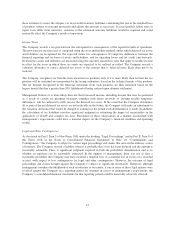Apple 2013 Annual Report Download - page 40
Download and view the complete annual report
Please find page 40 of the 2013 Apple annual report below. You can navigate through the pages in the report by either clicking on the pages listed below, or by using the keyword search tool below to find specific information within the annual report.the Company sometimes include indemnification provisions under which the Company could be subject to costs
and/or damages in the event of an infringement claim against the Company or an indemnified third-party.
However, the Company has not been required to make any significant payments resulting from such an
infringement claim asserted against it or an indemnified third-party. In the opinion of management, there was not
at least a reasonable possibility the Company may have incurred a material loss with respect to indemnification
of end-users of its operating system or application software for infringement of third-party intellectual property
rights. The Company did not record a liability for infringement costs related to indemnification as of
September 28, 2013 or September 29, 2012.
The Company has entered into indemnification agreements with its directors and executive officers. Under these
agreements, the Company has agreed to indemnify such individuals to the fullest extent permitted by law against
liabilities that arise by reason of their status as directors or officers and to advance expenses incurred by such
individuals in connection with related legal proceedings. It is not possible to determine the maximum potential
amount of payments the Company could be required to make under these agreements due to the limited history of
prior indemnification claims and the unique facts and circumstances involved in each claim. However, the
Company maintains directors and officers liability insurance coverage to reduce its exposure to such obligations,
and payments made under these agreements historically have not been material.
Critical Accounting Policies and Estimates
The preparation of financial statements and related disclosures in conformity with U.S. generally accepted
accounting principles (“GAAP”) and the Company’s discussion and analysis of its financial condition and
operating results require the Company’s management to make judgments, assumptions, and estimates that affect
the amounts reported in its consolidated financial statements and accompanying notes. Note 1, “Summary of
Significant Accounting Policies” of the Notes to Consolidated Financial Statements in Part II, Item 8 of this
Form 10-K describes the significant accounting policies and methods used in the preparation of the Company’s
consolidated financial statements. Management bases its estimates on historical experience and on various other
assumptions it believes to be reasonable under the circumstances, the results of which form the basis for making
judgments about the carrying values of assets and liabilities. Actual results may differ from these estimates and
such differences may be material.
Management believes the Company’s critical accounting policies and estimates are those related to revenue
recognition, valuation and impairment of marketable securities, inventory valuation and valuation of
manufacturing-related assets and estimated purchase commitment cancellation fees, warranty costs, income
taxes, and legal and other contingencies. Management considers these policies critical because they are both
important to the portrayal of the Company’s financial condition and operating results, and they require
management to make judgments and estimates about inherently uncertain matters. The Company’s senior
management has reviewed these critical accounting policies and related disclosures with the Audit and Finance
Committee of the Company’s Board of Directors.
Revenue Recognition
Net sales consist primarily of revenue from the sale of hardware, software, digital content and applications,
peripherals, and service and support contracts. The Company recognizes revenue when persuasive evidence of an
arrangement exists, delivery has occurred, the sales price is fixed or determinable, and collection is probable.
Product is considered delivered to the customer once it has been shipped and title and risk of loss have been
transferred. For most of the Company’s product sales, these criteria are met at the time the product is shipped.
For online sales to individuals, for some sales to education customers in the U.S., and for certain other sales, the
Company defers revenue until the customer receives the product because the Company retains a portion of the
risk of loss on these sales during transit. The Company recognizes revenue from the sale of hardware products,
software bundled with hardware that is essential to the functionality of the hardware, and third-party digital
content sold on the iTunes Store in accordance with general revenue recognition accounting guidance. The
38
























